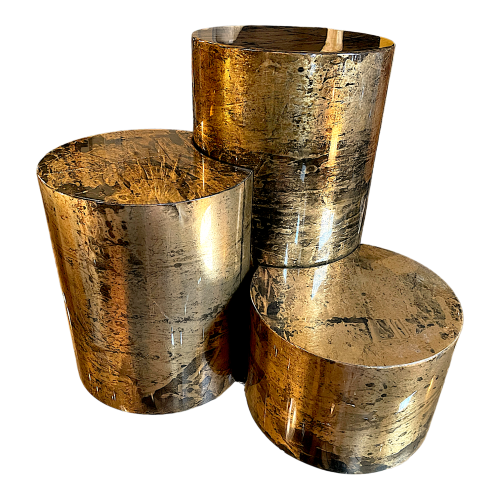Set of 3 gilded tables (67, 47, 27cm) or modular bases, attributed to Gabriella Crespi, ca 1970/80.
Covered in goatskin parchment, oxidised brass or bronze, anodised aluminium, typical of Italian design from the 1960s/80s.
Period epoxy resin coating (anti-scratch protection).
Good overall condition, with a slight linear crack on the epoxy surface of the medium table (not very visible, not disturbing) and a ding on the epoxy surface on the side of the largest table (invisible when the tables are assembled), see red arrows in the last 2 photos.
In the taste of Hollywood Regency and Brutalist style furniture by Karl Springer or Paul Evans for Todd Merrill Studio, Aldo Tura, Romeo Rega but also Ado Chale...
- Artist / Designer:Gabriella Crespi (attributed) (1922-2017)
- Period:20th Century / Mid Century / 1970-80
- Country of Origin:Italy
- Dimensions (H x W x D):67 x 85 x 85 cm
- Weight:15 Kg
- Number of components:3
- Condition:Good (see description)
- Style:Glam Seventies / Luxe Cool / Hollywood Regency
- Material:Resine
-
Price:SOLD
- Pick-up:Free
- Belgium Delivery:100€
- France Delivery:120€
- Europe Delivery:150€
- Worldwide Delivery:On request
Biography:
Gabriella Crespi studied architecture at the Politecnico di Milano. A sought-after interior designer and decorator in the 1960s and 1970s, her clients included Grace Kelly, Gunther Sachs, the Shah of Iran and King Faisal of Saudi Arabia. A mix of cool luxury, seventies glamour and timeless elegance, the quintessence of chic... She designed objects and furniture for Dior. Her creations include the Yang Yin table, Ellisse, the Plurimi coffee tables, the 2000 coffee table, the Menhir shelf, a bestiary of rhinoceros and penguin statues... She made a name for herself in 1974-1975 with her Asian-inspired Rising Sun bamboo furniture and the Fungo lamp. In 1982, an exhibition of her work was held at the Leonardo da Vinci Museum in Milan. Associated with the 1970s, her popularity declined at the end of the twentieth century, as her creations were considered kitsch. From the early 2000s onwards, however, her creations began to attract collectors again. In 2008, Stella McCartney included jewellery by Gabriella Crespi in her accessories collection. In 2013, Angelo Ruggeri, artistic director of Sergio Rossi, and its CEO, Christophe Mélard, were inspired by the shape of furniture she had designed to create accessories.
